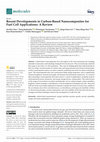Papers by Pitchaimani Veerakumar

Molecules
Carbon-based nanocomposites have developed as the most promising and emerging materials in nanosc... more Carbon-based nanocomposites have developed as the most promising and emerging materials in nanoscience and technology during the last several years. They are microscopic materials that range in size from 1 to 100 nanometers. They may be distinguished from bulk materials by their size, shape, increased surface-to-volume ratio, and unique physical and chemical characteristics. Carbon nanocomposite matrixes are often created by combining more than two distinct solid phase types. The nanocomposites that were constructed exhibit unique properties, such as significantly enhanced toughness, mechanical strength, and thermal/electrochemical conductivity. As a result of these advantages, nanocomposites have been used in a variety of applications, including catalysts, electrochemical sensors, biosensors, and energy storage devices, among others. This study focuses on the usage of several forms of carbon nanomaterials, such as carbon aerogels, carbon nanofibers, graphene, carbon nanotubes, and ...
ACS Applied Materials & Interfaces
Nanoscale
Correction for ‘A robust Mn@FeNi-S/graphene oxide nanocomposite as a high-efficiency catalyst for... more Correction for ‘A robust Mn@FeNi-S/graphene oxide nanocomposite as a high-efficiency catalyst for the non-enzymatic electrochemical detection of hydrogen peroxide’ by Shaktivel Manavalan et al., Nanoscale, 2020, 12, 5961–5972.

Journal of Electroanalytical Chemistry, 2021
In this work, a cost-effective, simple and scalable synthesis of nanostructured magnesium cobalt ... more In this work, a cost-effective, simple and scalable synthesis of nanostructured magnesium cobalt oxide (MgCo2O4) was presented by various methods. The structural morphology was evaluated by powder X-ray diffraction (XRD), field emission scanning electron microscopy (FESEM), Raman, Fourier-transform infrared spectrometry (FTIR), and X-ray photon spectroscopies (XPS). Further, electrochemical measurements by electrochemical impedance spectroscopy (EIS), cyclic voltammetry (CV), and differential pulse voltammetry (DPV) revealed that the MgCo2O4-modified electrode showed good sensitivity (0.895 µA µM–1 cm–2), a wide linear range (0.5−1145.8 μM) and a relatively low detection limit (0.047 μM) towards the electrochemical determination of thioridazine (TZ, antipsychotic drug). Loading catalyst, pH, scan rate, and peak potential of TZ were optimized. The modified sensor features excellent anti-interference ability, good cyclic stability, high reproducibility, and repeatability. The system h...
Journal of Materials Chemistry C
In this work, ultrafine rhenium-ruthenium nanoparticle decorated on functionalized carbon nanotub... more In this work, ultrafine rhenium-ruthenium nanoparticle decorated on functionalized carbon nanotubes (Re-Ru@f-CNT) were used as a new electrode platform for simultaneous electrochemical detection of nitrofurantoin (NFT, antibiotic) and flutamide (FLT,...
Chemical Engineering Journal

Langmuir
A new electrochemical sensor has been constructed based on the in situ preparation of gold nanopa... more A new electrochemical sensor has been constructed based on the in situ preparation of gold nanoparticle embedded on reduced graphene oxide and polypyrrole nanotube (AuNP@rGO/PPyNT) composite through a nanosecond laser-induced heating technique. The as-prepared composite is used for individual as well as the simultaneous electrochemical determination of chemotherapy drug (furazolidone, FU) and anticancer drug (flutamide, FLT). The composite was analyzed by X-ray Diffraction, scanning electron microscopy/energy-dispersive X-ray analysis, transmission electron microscopy, Raman spectrometry, and X-ray photoelectron spectroscopy analysis, thus confirming the successful synthesis of this composite and its physical features. The modified AuNP@rGO/PPyNT electrode was examined through cyclic voltammetry and differential pulse voltammetry (DPV) methods in pH 7.0 for the determination of FU and FLT in individual, simultaneous, and mixed systems. The fabricated sensor showed wide linear responses (0.01-1080.11 μM and 0.01-1214.11 μM) of analytes, with the lower limits of detection of 2.3 and 2.45 nM and higher sensitivity of 53.75 and 50.06 μA μM-1 cm-2, respectively. Furthermore, the constructed sensor demonstrates higher stability, reproducibility, and repeatability, and is effectively applied for the analysis of FU and FLT content in the human serum sample analysis with satisfactory recovery.
Nanoscale
Electrochemical determination of dopamine (DA) and clozapine (CLZ) in real samples is demonstrate... more Electrochemical determination of dopamine (DA) and clozapine (CLZ) in real samples is demonstrated using Bi–Sn NP/CAG nanocomposite.

Journal of Materials Science: Materials in Electronics
In this study, silver nanoparticle embedded on guar gum (AgNP/GG) nanocomposite was synthesized t... more In this study, silver nanoparticle embedded on guar gum (AgNP/GG) nanocomposite was synthesized thoroughly in greenway via a simple in situ method by silver salt reduction using the guar gum (GG) polymer matrix. The highly water-soluble polysaccharide material (GG) was served as both stabilizing and reducing agent. Its structure and morphology were characterized by XRD, FT-IR, TEM, and UV−Vis spectroscopy. EIS, CV, and DPV methods have also been employed to investigate the electrochemical performance of the AgNP/GG nanocomposite. Analytical parameters such as loading amount of catalyst, scan rate, pH value, cyclic stability, repeatability, and reproducibility were optimized. The AgNP/GG/SPCE shows a distinct electrocatalytic oxidation of diphenylamine (DPA) in a wide linear range (WLR) of 0.01−9.09 µM, a higher sensitivity of 6.879 µM cm −2 , and a limit of detection (LoD) of 5.4 nM (S/N = 3). The fabricated electrode exhibits an outstanding electrocatalytic performance in terms of good reproducibility, high stability, and acceptable anti-interference ability. In addition, this work advances the feasibility to determine DPA in apple juice sample with satisfactory recovery results.
ACS Sustainable Chemistry & Engineering
In the present work, we report a one-step pyrolysis synthesis of molybdenum nitride nanorods (MoN... more In the present work, we report a one-step pyrolysis synthesis of molybdenum nitride nanorods (MoN NRs) using ammonium heptamolybdate tetrahydrate as a precursor. Properties of MoN NRs have been imp...
ACS Applied Electronic Materials
In this work, we developed a Sr-doped FeNi-S nanoparticle by a simple one-step pyrolysis process ... more In this work, we developed a Sr-doped FeNi-S nanoparticle by a simple one-step pyrolysis process and successfully integrated it with single-walled carbon nanotubes (Sr@FeNi-S/SWCNTs) using an ultra...

Nanomaterials
The inhibition of platelet activation is considered a potential therapeutic strategy for the trea... more The inhibition of platelet activation is considered a potential therapeutic strategy for the treatment of arterial thrombotic diseases; therefore, maintaining platelets in their inactive state has garnered much attention. In recent years, nanoparticles have emerged as important players in modern medicine, but potential interactions between them and platelets remain to be extensively investigated. Herein, we synthesized a new type of carbon dot (CDOT) nanoparticle and investigated its potential as a new antiplatelet agent. This nanoparticle exerted a potent inhibitory effect in collagen-stimulated human platelet aggregation. Further, it did not induce cytotoxic effects, as evidenced in a lactate dehydrogenase assay, and inhibited collagen-activated protein kinase C (PKC) activation and Akt (protein kinase B), c-Jun N-terminal kinase (JNK), and p38 mitogen-activated protein kinase (MAPK) phosphorylation. The bleeding time, a major side-effect of using antiplatelet agents, was unaffect...
Journal of Materials Chemistry C
In this work, gold nanoparticle (Au NP) decorated poly(diallyldimethylammonium chloride) (PDDA) f... more In this work, gold nanoparticle (Au NP) decorated poly(diallyldimethylammonium chloride) (PDDA) functionalized graphene hydrogel (Au NP@PDDA/GH) nanocomposites were fabricated.
Chemosphere
Palladium plays a pivotal role in most of the industrial heterogeneous catalysts, because of its ... more Palladium plays a pivotal role in most of the industrial heterogeneous catalysts, because of its unique properties such as well-defined structure, great intrinsic carrier, outstanding electronic, mechanical and thermal stability. The combination of palladium and various porous carbons (PCs) can widen the use of heterogeneous catalysts. This review highlights the advantages and limitations of carbon supported palladium-based heterogeneous catalyst in reduction of toxic hexavalent chromium (Cr(VI)). In addition, we address recent progress on synthesis routes for mono and bimetallic palladium nanoparticles supported by various carbon composites including graphene-based materials, carbon nanotubes, mesoporous carbons, and activated carbons. The related reaction mechanisms for the Cr(VI) reduction are also suggested. Finally, the challenge and perspective are proposed.
New Journal of Chemistry
A fabricated Sr-doped NiO3 nanorod-modified GCE was developed for electrochemical sensing of quer... more A fabricated Sr-doped NiO3 nanorod-modified GCE was developed for electrochemical sensing of quercetin.

Microchimica Acta
The two-step microwave method was used to synthesize zinc oxide nanostars linked to graphene oxid... more The two-step microwave method was used to synthesize zinc oxide nanostars linked to graphene oxide (GO) nanosheets. The material was used to modify a screen printed carbon electrode (SPCE) and then explored as a binder-free electrocatalyst for the electrochemical determination of methyl parathion (MP). The morphology and crystallinity of the material were characterized by various techniques. The modified SPCE shows extraordinary electrochemical performances for sensitive determination of MP. Figures of merit include (a) a wide linear dynamic range (0.03–670 μM), (b) a low detection limit (1.2 nM; at S/N = 3), (c) a comparably low working voltage (−0.69 V vs. Ag/AgCl); and (d) an excellent sensitivity (16.5 μA μM−1 cm−2) that surpasses other modified electrodes. The sensor was successfully applied to the determination of MP, even in the presence of other common electroactive interference, in (spiked) fruits and vegetables. Graphical abstract Graphene oxide anchored three-dimensional zinc oxide nanostars were used to coat electrode for the sensing of methyl parathion (MP) by voltammetry Graphene oxide anchored three-dimensional zinc oxide nanostars were used to coat electrode for the sensing of methyl parathion (MP) by voltammetry






Uploads
Papers by Pitchaimani Veerakumar